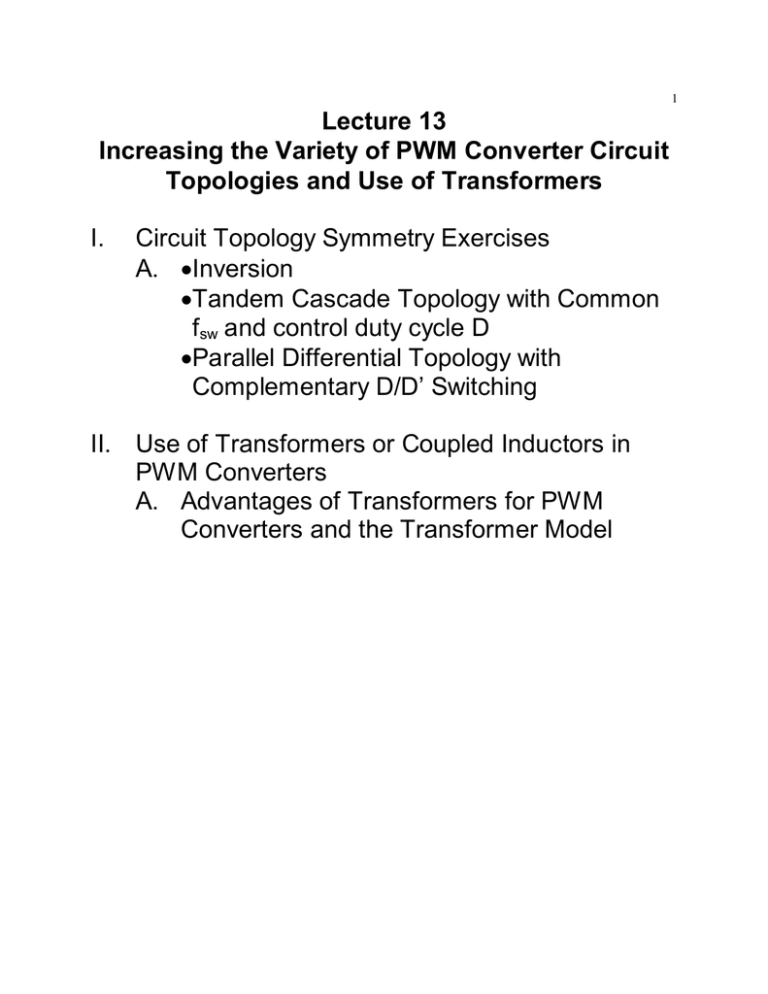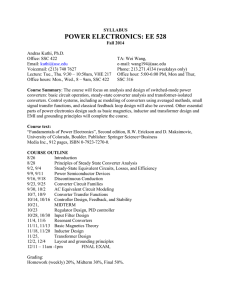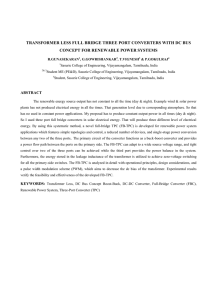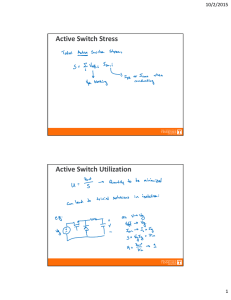Week 13
advertisement

1 Lecture 13 Increasing the Variety of PWM Converter Circuit Topologies and Use of Transformers I. Circuit Topology Symmetry Exercises A. • Inversion • Tandem Cascade Topology with Common fsw and control duty cycle D • Parallel Differential Topology with Complementary D/D’Switching II. Use of Transformers or Coupled Inductors in PWM Converters A. Advantages of Transformers for PWM Converters and the Transformer Model 2 I. Circuit Topology Symmetry Exercises This section is optional. A. Inversion, Tandem - Cascade and Parallel - Differential. 1. Inversion Consider the switched inductor in the two topologies below where position 2 is a shunt to ground and position 1 is a series connection. We will keep the same topology but switch power and load as well as switch duty cycles to change circuit function. P(flow) DC Supply P(flow) RC load Switched L RC load Keep this switch topology the same 1 2 Switched L Vo Flip the source and load DC Supply • Top circuit with power flow left to right is the basic buck with M = V o = D , where D is the fractional duration the switch is in Vg position 1 connecting DC to the inductor during the time Ts interval. During D’the inductor is grounded. Power flow is next reversed to right to left in the bottom circuit. 1 • Bottom circuit is a basic boost with M = V o = , D Vg 3 where now in contrast to the first case D is given by the amount of time the switch is in position 2 connected to ground during the time interval Ts. L builds up i during D as in a conventional boost. During D’the inductor is connected to the load on the left. Power flows right to left in the case we are in Position 2 with 2 the power supply connected to ground through L. When in position 1 the power flows from L into the load on the left. This exercise in circuit topology and switching timing points out the big difference these little changes make. 1 The switches for the two cases when implemented by solid state transistors and diodes might appear as below: Top power flow → ← Bottom power flow port 1 L iL(t) + vL(t) - Vg D1 + Q1 C DTs Ts port 2 D1 R v - L + R C + V1 V2 - Power flow Note how the actively controlled switch (the transistor) brings with it the role of control determined by D. Conclusion: Boost converter is just a rewired buck converter with the switch timing reset and the proper switches employed 4 2. Tandem - Cascade With Common Switch Timing fsw Converter 1 Converter 2 + V1 - Vg V1/Vg=M1(D) + V - V/V1=M2(D) R D For ideal individual converter blocks with: Zo = 0 ⇒ Vo = M1M2 Zin = ∞ ⇒ V g Consider a tandem cascade two stage buck and then a boost. V M1 (D) = 1 = D The Buck gives: Vg V 1 The Boost yields: M 2 (D) = = D′ V1 L1 1 L2 2 + + Vg 2 C1 V1 1 C2 R - Buck converter Boost converter The series combination |M(D)| gives ⇒ V V V Vg = +D but note 1- D is always positive polarity because 0 ≤ D ≤ 1. Compare these Vg results to our prior M(D) for the simple single inductor buck-boost 5 -D +D . Whereas, the M(D) of the tandem cascade is . 1- D 1- D The only difference is not just the sign as the EMI effects are very different. which is Note also that D = ½ is a pivot point for the Vo/Vg ratio about unity value. V o < 1 for D < 1 and V o > 1 for D > 1 2 2 Vg Vg V o = 1 for D = 1 . 2 Vg This tandem cascade has worst of both buck and boost circuits as far as conductive EMI is concerned. Boost Vg Buck Vo M1(D)=1/(1-D) M2(D)=D same timing fsw D Pulsating Iin of buck ⇒ Polluting the mains with conductive EMI Pulsating Iout of boost ⇒ Polluting the output with conductive EMI Compare this to the simple single inductor buck-boost circuit which gives the same over all M(D) but: Iin for the boost is non-pulsating Non-polluting ⇒ conductive EMI Iout for the buck is non-pulsating to both input and output This is equivalent to an inverting (only +) Cuk converter 6 3. Parallel - Differential with Complementary D-D’Switching at fsw We seek an AC output of either polarity. load converter 1 V1=M(D)Vg + V1 - Vg + Vo = V 1 - V 2 D converter 2 V2=M(D')Vg - + V -2 D' Goal: Bipolar Vout about zero volts from two unipolar converters Unipolar + output only is achieved from: 1. Buck 2. Boost Both cannot give - Vout. Unipolar - output only was achieved from: 1. Cuk 2. Buck-boost Neither can give +Vo. Yet when run differentially: Vout = V1 - V2 we can achieve bipolar output. Where V1 is set by M(D)Vg and V2 = M(D’)Vg. ⇒ Bipolar output without dc bias is the result V1 ↑ and V2 ↓ sets Vo positive while V1 ↓ and V2 ↑ sets Vo negative. 7 Consider the two parallel - differential bucks below: L1 1 + Vg V - L1 1 The switch timing in this differential circuit pair is complementary. Top switch: Bottom switch: sw1 cycle for duration D sw2 for duration D Top voltage Lower voltage DVg D’Vg Vo(DC) = Vg (D - D’) = (2D - 1)Vg This same DC M(D) is also achieved by the circuit called the voltage fed bridge and was Problem 2.4 for a prior homework. Its M(D) versus D plot and circuit diagram are: M(D) C 1 1 Vg 0 D 0.5 1 2 L iL 2 + V 1 R -1 Note that the switches here operate so that both are 1 or 2. 8 II. Use of Transformers or Coupled Inductors in PWM Converters All of the three PWM circuit topologies discussed so far do not have electrical isolation between the input and the output. That is both the input and the output share a common electrical terminalthe ground connection. Moreover, to get the desired output we need rely entirely on the duty cycle via M(D). By placing high frequency transformers in the circuits, that operate at fsw , we can use the turns ratio to allow a wider range of outputs with a narrower range of duty cycles. This added flexibility in circuit design to achieve both dielectric isolation and step up or step down the PWM signal at fsw is desirable to better achieve cost – performance tradeoffs. For example, to use the turns ratio to trade off duty cycle and switch stress from over current or over voltage outside their safe operating areas (SOA). A. Advantages of Transformers or Coupled Inductors in PWM Converters For all prior converters the input and output shared a common ground. We are about to change this constraint. 1. Also bigger V or I step-up/step-down is easier to achieve just use the turns ratio alone or we may trade off the transformer turns ratio versus the switch control duty cycle. 2. Now we can isolate input/output circuits and remove the common ground 3. We can now get multiple transformer outputs from one input via a multi-winding.transformer.secondary on a single core. For example, winding #1 for the input and windings 2-4 for three separate relative outputs set only by the number of turns in each winding. This is great for achieving the multiple voltages a computer system requires, for example, (+3V, +15V, +10kV). On the next page we show several examples of multiple secondary output windings. 9 First is the flyback transformer secondary with three secondary arrangements: •Center-tapped to get +/- Vout •Two separate and electrically isolated secondaries Notice how the simple use of a transformer operating at fsw allows us to get many advantages with the only price that we have to pay is the time and effort to wind up some complex copper wire arrangements on magnetic cores. 10 Second, is the output transformer circuits for both forward and flyback converters. 4. Gate drive Transformers We deliver VGS without any worries about DC level mismatches nor any worries about different grounds in the driver and the switch. For a gate drive transformer we should insure: •Dielectric isolation of TWICE Vin •Do not employ too high a turns ratio to avoid avalanching of the gate during turn off •Drive the transformer in bipolar fashion to avoid core saturation. Or put an air gap in the core to avoid saturation 11 5. Comparison of PWM Converters We now compare the old big three converters (buck, boost and buck-boost) to five new converter topologies that we will be introducing in lectures 14-16. All of the new five topologies will have transformer isolation.. Moreover, as we will see each new topology has a specific power range over which it works best. Below we list converters in ascending order of the power level they can handle as well as the voltage levels. In general, the higher power and voltage level topologies have 2-4 switches rather than the single switch of the big three topologies. 12 B. Transformer model A two winding transformer with given core characteristics and associated electrical equivalent circuit model are given below. The ingredients are the copper turns around a common magnetic core. Briefly the core B - H and loss versus B are given below. 3C8 Ceramic Ferrite 1Wb ↔ 10 4 Gauss is the saturation flux, Bm. 2 m Note also for this core material for f > 100 kHz core loss is excessive. On the next page we will make the observation that the core B-H curve has four quadrants that we can excite. H corresponds to the current in the inductor through the NI= H x core length relationship. Each converter topology has unique current waveforms associated with the inductor. Specifically, some are such that the current is unipolar and never goes negative, while other topologies have bipolar current waveforms in the inductor. 13 Notice the four quadrants to B - H curves. How we use them depends on the IL vs. time waveform. B II I Bm A Br N1 . B N2 H III . C D IV Lt1 Lt2 A . . + i1 B v1 - Lm N1:N2 + v2 - i2 C D Consider the case of the magnetizing inductance on a core of magnetizing path lc and flux path Ac with N turns of copper wire µr µ o N2 wound around it: LM = lc . Moreover, im is small when Ac Lm is big. Note: if im is too big then above im(crit), LM suddenly changes by a factor µr downwards toward lower LM due to core saturation. We approximate this as L → 0 and shorts out the input or output to the ideal transformer. This is a potential short that causes switch failure and MUST BE AVOIDED. Circuits don’t like sudden shorts, nor do switches. On the next page we also show the model for a transformer that includes the fact that for FINITE permeability the magnetic flux is not totally contained in the core. This gives rise to leakage fluxes and leakage inductances on REAL TRANSFORMERS. We need to account for these elements in any models of operation. 14 Lt1 and Lt2 are leakage or parasitic inductance’s due to the flux which does not stay in the magnetic core. Lm is the magnetizing inductance of the core representing the portion of the input current going to set up the core B-field. Generally, Lt1 and Lt2 are small but non-negligible. These leakage inductances cause series voltage transients to occur due to changes in the sign of di/dt during switching. These additional voltages cause increased switch stress on the solid state devices and possible failure. Generally we want im small and thus Lm large. The exception is the flyback converter of section II.C. where Lm is small purposely and im is large so that we store energy on one portion of Ts and deliver it on another. That is in the flyback transformer only primary current flows during D and only secondary current during D’. The portions of B - H curves used for the same core placed in different circuit topologies are unique. Hence, core losses vary with I being unipolar or bipolar. 15 We will find that some converters because of current waveforms use the following quadrants of the B-H curves: 1. Only quadrant I of the core magnetics are employed since im will only be positive and never negative due to passive clamps like diodes. For example both the Flyback derived from buck/boost (Section II.C.) and the Forward converter derived from the buck circuit (Section II.D.) have unipolar current flow. The point to note is merely that the inductor current is UNIPOLAR for this half-forward converter topology. On the next page we will give the circuit and waveforms for the forward converter with the same message in mind –that the currrent waveforms are unipolar. 16 Notice that the diode prevents the inductor current from ever going negative-thereby insuring that we are operating only in the first BH quadrant only. This is termed UNIPOLAR EXCITATION. 17 Unipolar Core Excitation: B Forward or flyback converter v1 0.4Wb/m2 Bm Br Vd 0.1Wb/m2 H 0 ton im t toff (-Vd) B ( B)max 0 Ts(=1/fs) To avoid core saturation we would need to specify from the core characteristics that B(DC) was halfway up the core characteristic and that: ( ∆ B )max < Bm Br 2 ( ∆ B) max ∝ i m = function of converter duty cycle: f(D) Core loss = k fn(∆B)Nmax is a function of the maximum not the average ∆B excursion. Problem is excessive core loss at fsw > 50 - 300 kHz We want to shift B - H curves to reduce (∆B)max. One can make Br → 0 by two means 1. Choose low Br material for the core. 2. Cut an air gap in the core to linearize B-H curve and reduce Br. The two winding flyback inductor or transformer is unique because the designer: 1. Purposefully makes Lm large 2. Air gap is very wide both for large energy storage and to make Br small for given ∆H 18 B solid core core with an air gap H im An air gap in the magnetic core helps prevent core saturation at high H or im which would lead to Lm → 0 and high peak input currents are drawn by the transformer killing switches. 2. Both quadrant I and III Operation For a given core Bsat occurs after a specific current swing is traversed. We easily saturate using one quadrant but have half the likelihood with two quadrant operation. Therefor, we could place B(DC) at zero and then use bipolar current drive. There is less likelihood of core saturation since ∆B is divided over two quadrants of B - H. For example: push pull converters and full bridge converters as will be discussed in more detail in lecture 14-16 both employ bipolar I versus time waveforms to drive the cores. This highlights one of the advantages of high switching frequencies - the better avoidance of transformer saturation due to less excursion in current waveforms. Also for all other things equal, transformers operating at high fs ⇒ smaller size and smaller weight core are possible for the same inductor. Compare transformer core size required for 60 kHz and for 60 Hz(mains). dφ e = N = Nw φ. For the same induced voltage we use either dt 1000 times less copper wire (N) or 1000 times less magnetic core material by increasing the frequency of the sinusoidal variation by 1000. 19 Vd . (core area) f s We DECREASE the maximum excursion of flux by employing HIGHER fsw. Note also more copper wire turns ,N1, also decreases the maximum flux and avoids FATAL CORE SATURATION ( ∆ B) max = N12 Bipolar Core Excitation: Bridge converters purposefully apply asymmetric ±B to the transformer core to avoid saturation. v1 B Bm Vd H 0 ton im t toff (-Vd) B ( B)max 0 Ts(=1/fs) ( ∆ B )max < BM if we want to avoid core saturation. ( ∆ B )max is related to the Hmax which is related to the NImax. Imax in an inductor is given for a square wave of voltage by di=Vddt/L. µl N12 Vd Now L = and ℜ = or: ∼ di ∼ ∆Bmax 2 (Core Area ) ℜ A N1 f s Assuming we avoid core saturation the core loss varies as ∆Bmax to some power or (di)N. ( ∆ B )max ↑ ⇒ smaller core area or smaller core size. 20 We repeat the major messages of avoiding core saturation to date: fs decreases ( ∆ B )max ↑ N1 decreases ( ∆ B )max ↑ . If transformers are so great, what’s the other down sides besides core saturation? We will discuss this in detail in Lecture 14. FOR HW# 3 Do Problems 7,8 and 11 in Erickson Chapter 6. Get started immediately and do problems 7 and 8 immediately as problem 11 will take a lot of time to complete. The use of Mathcad and spread sheets or similar tools is strongly suggested for #11. Please make the worst case stress analysis in this automated way. If time allows I will give in class some hints for #11




